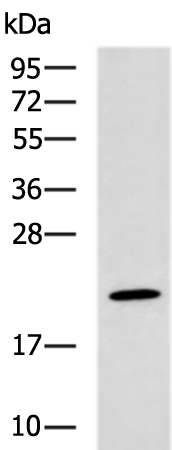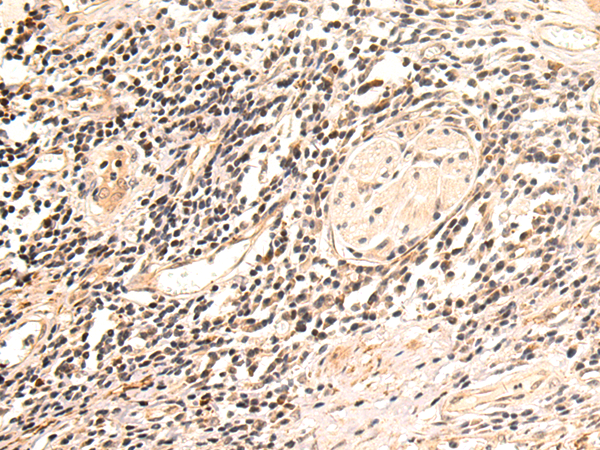

| WB | 咨询技术 | Human,Mouse,Rat |
| IF | 咨询技术 | Human,Mouse,Rat |
| IHC | 1/50-1/100 | Human,Mouse,Rat |
| ICC | 技术咨询 | Human,Mouse,Rat |
| FCM | 咨询技术 | Human,Mouse,Rat |
| Elisa | 1/5000-1/10000 | Human,Mouse,Rat |
| Aliases | HSMT3; SMT3B; SUMO3; Smt3A; SMT3H2; SMT3A; Smt3B; SMT3H1; SUMO-3; IDDM5; SMT3H4; SUMO-4; dJ281H8.4 |
| WB Predicted band size | 11 kDa |
| Host/Isotype | Rabbit IgG |
| Antibody Type | Primary antibody |
| Storage | Store at 4°C short term. Aliquot and store at -20°C long term. Avoid freeze/thaw cycles. |
| Species Reactivity | Human, Mouse, Rat |
| Immunogen | Synthetic peptide of human SUMO2/SUMO3/SUMO4 |
| Formulation | Purified antibody in PBS with 0.05% sodium azide and 50% glycerol. |
+ +
以下是关于SUMO2/SUMO3/SUMO4抗体的3篇参考文献及其摘要概括:
---
1. **文献名称**: *Proteomic analysis of SUMO2/3 modification in human cells*
**作者**: Matic, I. et al.
**摘要**: 该研究开发了特异性识别SUMO2/3共轭物的抗体,并利用质谱技术系统鉴定了人细胞中SUMO2/3修饰的底物蛋白,揭示了SUMO2/3在应激反应和DNA修复中的独特功能。
2. **文献名称**: *SUMO4 genetic polymorphisms and association with type 1 diabetes susceptibility*
**作者**: Baba, H. et al.
**摘要**: 通过使用SUMO4特异性抗体,研究发现SUMO4基因多态性与1型糖尿病风险相关,并探讨了SUMO4在炎症信号通路中的作用,强调了抗体在检测SUMO4表达中的关键性。
3. **文献名称**: *Distinct roles for SUMOylation in the localization and activity of cellular proteins*
**作者**: Gareau, J.R. & Lima, C.D.
**摘要**: 该文献比较了SUMO1、SUMO2/3和SUMO4抗体的特异性,揭示了不同SUMO亚型在亚细胞定位和底物修饰中的差异,为研究SUMO家族功能提供了抗体选择的实验依据。
---
**说明**:上述文献涵盖了SUMO2/3抗体的功能研究、SUMO4抗体的疾病关联分析以及不同SUMO抗体特异性的比较,适用于靶向研究SUMO修饰机制的实验设计。如需具体实验方法或抗体货号,可进一步查阅原文。
SUMO (Small Ubiquitin-like Modifier) proteins, including SUMO1-4. are involved in post-translational modifications (SUMOylation) that regulate protein localization, stability, and interactions. SUMO2 and SUMO3 share ~95% sequence identity, forming poly-SUMO chains under stress, while SUMO1 is structurally distinct. SUMO4. less characterized due to restricted _expression (e.g., kidneys, immune cells), contains a polymorphism linked to diabetes risk. Antibodies targeting SUMO2/3/4 are essential tools for studying SUMOylation dynamics.
SUMO2/3 antibodies often cross-react due to high homology but can differentiate from SUMO1. They detect SUMOylation changes in stress responses (e.g., heat shock, proteasome inhibition) via techniques like Western blot, immunofluorescence, or immunoprecipitation. SUMO4-specific antibodies are less common, reflecting its limited functional overlap and tissue-specific roles. Challenges include distinguishing SUMO2 from SUMO3. requiring epitope-specific antibody validation (e.g., knockout cell lines).
These antibodies aid in exploring SUMOylation’s role in diseases (e.g., cancer, neurodegeneration) and cellular processes (DNA repair, transcriptional regulation). Researchers must verify antibody specificity to avoid off-target effects, particularly when studying poly-SUMO chains or SUMO4-associated pathways.
×